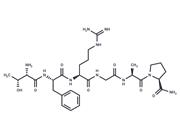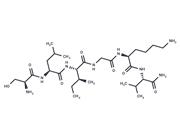| Name | Protease-Activated Receptor-1, PAR-1 Agonist acetate |
| Description | Protease-Activated Receptor-1, PAR-1 Agonist acetate is a selective proteinase-activated receptor1 (PAR-1) agonist peptide. Protease-Activated Receptor-1, PAR-1 Agonist acetate corresponds to PAR1 tethered ligand and which can selectively mimic theactions of thrombin via this receptor[1][2]. |
| In vitro | Protease-Activated Receptor-1, PAR-1 Agonist acetate induces activation of protein kinase C isoenzymes alpha and epsilon in human HT-29 colon carcinoma cells expressing PAR1 endogeneously. On the cellular level, Protease-Activated Receptor-1, PAR-1 Agonist acetate and thrombin prompted HT-29 cell migration and matrix adhesion by a PKCepsilon-dependent mechanism as concluded because of the inhibition of PAR1-mediated effects by the PKC inhibitor bisindolylmaleimide I and the PKCepsilon translocation inhibitory peptide EAVSLKPT but not by the PKC inhibitor G? 6976[2]. |
| Storage | keep away from moisture | Powder: -20°C for 3 years | In solvent: -80°C for 1 year | Shipping with blue ice/Shipping at ambient temperature. |
| Solubility Information | H2O : 20 mg/mL (24.3 mM), Sonication is recommended.
|
| Keywords | ProteaseactivatedReceptor | ProteaseActivated Receptor1, PAR1 Agonist acetate | Protease-Activated Receptor (PAR) | Proteaseactivated Receptor | Protease Activated Receptor 1, PAR 1 Agonist acetate |
| Inhibitors Related | FSLLRY-NH2 TFA(245329-02-6 free base) | TRAP-6 amide acetate | LRGILS-NH2 acetate | PAR-2 Activating Peptide acetate | ML-354 | Atopaxar | Vorapaxar sulfate | Trypsin | Vorapaxar | AY 77 | PAR-2-IN-1 | VKGILS-NH2 Acetate |
| Related Compound Libraries | Bioactive Compound Library | Membrane Protein-targeted Compound Library | Peptide Compound Library | Bioactive Compounds Library Max | GPCR Compound Library | Anti-Cancer Compound Library |

 United States
United States






